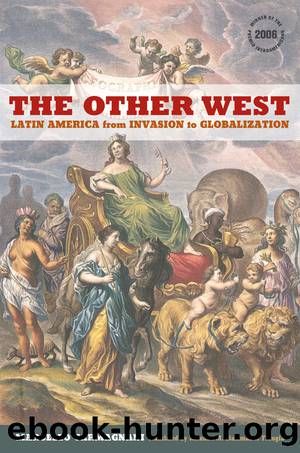The Other West by Marcello Carmagnani

Author:Marcello Carmagnani
Language: eng
Format: epub
ISBN: 9780520947511
Publisher: University of California Press
Published: 2012-01-23T00:00:00+00:00
The Birth of a Financial Economy
The subcontinentâs participation in international commerce was not just the result of a general acceleration of trade but also of the changes in the means of production encouraged by the new financial services. A financial economy could both facilitate commercial transactions and channel available capital on both sides of the Atlantic toward Latin America. This process, often demonized in the press of yesterday and of today, shows the growing interdependence of Latin America and Europe.
The financial innovations and their effects on the subcontinent are easier to understand by looking at the transition that took place in international trade payments, which from bilateral gradually became trilateral and then multilateral. This last form required financial and credit instruments to facilitate payment, so promissory notes, checks, and money orders became popular, and this led to the birth and spread of credit institutions and commercial and business banks. It drove the Latin American countries to see the international gold standard as the mechanism for regulating payments.
Their adoption of the gold standard for international exchange and financial transactions hastened the demise of a world that still in the 1850s ran on three types of currency: gold (first adopted by England); gold-silver (continental Europe), and silver, which was used in Latin America and Asia. At the same time all the economies began to use one of the three existing gold systems: pure, banking, or standard. Agreeing to use the gold standard unified, for the first time in history, the different payment systems in use since the sixteenth century, first on a regional, then national, level, channeling public and private finances to the financial center (at the time London), assisted by the great financial markets of Paris, Frankfurt, Berlin, Amsterdam, and New York and the secondary markets of Milan, Barcelona, and Buenos Aires.
In the nineteenth century commercial payments were settled with promissory notes drawn on London for Great Britain, the leading commercial partner, or Paris or Berlin for notes issued by trading houses and financial firms headquartered in London, Paris, or Berlin and with branches or correspondents in Latin America. These bilateral or trilateral forms of payment slowed Latin Americaâs performance because, in addition to limiting the growth of foreign trade, they did not favor the rise of banks and financial services in general. The only innovation before 1850 was the development in Atlantic Europe, Great Britain especially, of mercantile-financial concerns that, unlike the old mercantile houses, took on the financial risk of import and export trade, developing a wide network of agents in America and other non-European regions.
The participation of the Latin American economies in the multilateral system of payments was also hampered by the currency system, which used only one metalâsilverâin the countries that produced it such as Mexico, Bolivia, Peru, and Chile, while countries such as Argentina, Brazil, and Venezuela had a domestic payment system based on the circulation of fiduciary instruments or paper money, and foreign payments based on a gold premium. Furthermore, Latin America also had regulatory
Download
This site does not store any files on its server. We only index and link to content provided by other sites. Please contact the content providers to delete copyright contents if any and email us, we'll remove relevant links or contents immediately.
Cat's cradle by Kurt Vonnegut(13886)
Pimp by Iceberg Slim(12940)
Underground: A Human History of the Worlds Beneath Our Feet by Will Hunt(11264)
4 3 2 1: A Novel by Paul Auster(11071)
The Radium Girls by Kate Moore(10914)
American History Stories, Volume III (Yesterday's Classics) by Pratt Mara L(4828)
Perfect Rhythm by Jae(4628)
Wiseguy by Nicholas Pileggi(4598)
The Fire Next Time by James Baldwin(4349)
Paper Towns by Green John(4174)
A Higher Loyalty: Truth, Lies, and Leadership by James Comey(4038)
Pale Blue Dot by Carl Sagan(4014)
The Mayflower and the Pilgrims' New World by Nathaniel Philbrick(3917)
The Doomsday Machine by Daniel Ellsberg(3736)
Too Much and Not the Mood by Durga Chew-Bose(3697)
Killers of the Flower Moon: The Osage Murders and the Birth of the FBI by David Grann(3621)
The Borden Murders by Sarah Miller(3592)
The Sympathizer by Viet Thanh Nguyen(3506)
Killing England by Bill O'Reilly(3459)
